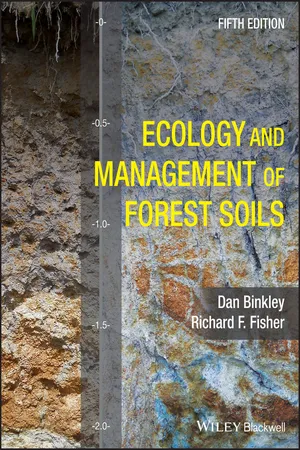
- English
- ePUB (mobile friendly)
- Available on iOS & Android
Ecology and Management of Forest Soils
About this book
Contemporary soil science and conservation methods of effective forestry
Forests and the soils that serve as their foundation cover almost a third of the world's land area. Soils influenced by forest cover have different properties than soils cultivated for agricultural use. Ecology and Management of Forest Soils provides a clear and comprehensive overview of the composition, structure, processes, and management of the largest terrestrial ecosystem. From composition and biogeochemistry to dynamics and management, this essential text enables readers to understand the vital components of sustainable, long-term forest soil fertility. The interaction of trees, animals, microbes, and vegetation alter the biology and chemistry of forest soils—these dynamics are also subject to human management, requiring conservationists to be conversant in the philosophy and methods of soil science.
Now in its fifth edition, this classic text includes new coverage of uptake of organic nitrogen in forests, 15N retention studies, the effects of N additions on C accumulation, evidence-based examples of the dynamics of soils, and more. Extensive updates and revisions to topics such as spatial implications of megafires, long?term organic matter accumulation, soil characterization, and molecular soil measurement techniques reflect contemporary research and practices in the field.
This informative overview of forest soils integrates clear and accurate descriptions of central concepts and logically organized chapters to provide readers with foundational knowledge of major soil features, processes, measurement techniques, and management methods. This authoritative survey of the management and ecology of forest soils:
- Offers full-color photographs and illustrations, real-world examples and case studies, and clear overviews to each topic
- Presents up-to-date and accessible coverage of contemporary forest science literature and research
- Addresses topical issues relevant to areas such as ecology, forest management, conservation, and government policy
- Provides a comprehensive, global perspective on forest soils, from tropical to temperate to boreal
- Presents balanced coverage of soil science principles and their practical application to forest management
Ecology and Management of Forest Soils offers students in areas of soil science and forestry, natural resource and environmental management, ecology, agronomy, and conservation an invaluable overview of the field, while providing forestry professionals an efficient and current work of reference.
Frequently asked questions
- Essential is ideal for learners and professionals who enjoy exploring a wide range of subjects. Access the Essential Library with 800,000+ trusted titles and best-sellers across business, personal growth, and the humanities. Includes unlimited reading time and Standard Read Aloud voice.
- Complete: Perfect for advanced learners and researchers needing full, unrestricted access. Unlock 1.4M+ books across hundreds of subjects, including academic and specialized titles. The Complete Plan also includes advanced features like Premium Read Aloud and Research Assistant.
Please note we cannot support devices running on iOS 13 and Android 7 or earlier. Learn more about using the app.
Information
CHAPTER 1
Soil Foundations
OVERVIEW
EVERYTHING IN FORESTS AND FORESTRY CONNECTS TO SOILS

FOREST SOILS HERE ARE DIFFERENT FROM OVER THERE

CURRENT FOREST GROWTH IS LIMITED BY SOIL RESOURCES ACROSS REGIONS


SOILS SHAPE FORESTS, AND FOREST SHAPE SOILS


Table of contents
- Cover
- Table of Contents
- Preface
- Dedication
- In Memoriam
- CHAPTER 1: Soil Foundations
- CHAPTER 2: Forest Soils Across Space and Time
- CHAPTER 3: Minerals in Forest Soils
- CHAPTER 4: Organic Matter in Forest Soils
- CHAPTER 5: Physics in Forest Soils
- CHAPTER 6: Life in Forest Soils
- CHAPTER 7: Chemistry of Soil Surfaces and Solutions
- CHAPTER 8: Biogeochemistry
- CHAPTER 9: Tree Species Influences
- CHAPTER 10: Characterizing Soils Across Space and Time
- CHAPTER 11: Soil Management
- CHAPTER 12: Fire Influences
- CHAPTER 13: Nutrition Management
- CHAPTER 14: Managing Forest Soils for Carbon Sequestration
- CHAPTER 15: Evidence‐Based Approaches
- References
- Index
- End User License Agreement